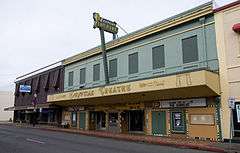Egyptian Theatre (Coos Bay, Oregon)
|
Egyptian Theatre | |
 | |
 | |
| Location | 229 S. Broadway, Coos Bay, Oregon |
|---|---|
| Coordinates | 43°22′00″N 124°12′47″W / 43.36680°N 124.21315°WCoordinates: 43°22′00″N 124°12′47″W / 43.36680°N 124.21315°W |
| Area | less than 1 acre (0.40 ha)[1] |
| NRHP Reference # | 10000281[2] |
| Added to NRHP | May 24, 2010[2] |
The Egyptian Theatre is a historic movie theatre in Coos Bay, Oregon, United States.[3] It was originally built as a garage, and was converted to a theatre in 1925.[1] With a seating capacity of 770, the theatre is an example of the Egyptian Theatre style of Egyptian Revival architecture that was popular in the early 20th century in the U.S., especially following the 1922 discovery of the tomb of King Tut. The building was listed on the U.S. National Register of Historic Places on May 24, 2010.[2] In fact it was announced as the featured listing in the National Park Service's weekly list of June 4, 2010.[4]
According to the National Park Service:
The Egyptian Revival style of architecture was favored for many years in Europe and popularized in the United States during the 1920s with the discovery of the tomb of King Tutankhamen. The style’s potential for exotic, mysterious theatricality lent itself well to movie palace design of the 1920s, but only four movie palaces in this style are documented as surviving in the United States today. One of those four is the Egyptian Theatre, located at 229 S. Broadway in downtown Coos Bay, Oregon. Originally built in 1922 as a garage and converted in 1925 to a movie palace, the theater is essentially unchanged, possessing its original style décor, light fixtures, and furnishings, including its bronze pharaoh statues, friezes depicting lotus, papyrus, discs, uraei, and ravens, columns painted with hieroglyphics and Egyptionesque characters, a proscenium above the stage featuring a replica of an ancient Egyptian temple, and original curtains and painted backdrops. The Egyptian Theatre is an excellent example of the Egyptian Revival style and it continues to function as a movie palace to this day.[5]
History
The Egyptian was built by Charles Noble, a descendant of one of the area's first settlers. Noble spent $200,000 to convert his service station and garage into the theater.[6] The building was designed by Lee Arden Thomas and Albert Mercier. It includes piers decorated with papyrus blossoms, wrought-iron ceiling lights in the form of hooded cobras, and stairways with 8-foot (2.4 m) pharaoh statues.[6]
Theatre interior
The theatre houses the only theatre organ still in place in its original theatre in Oregon,[7] a 4/18 Mighty Wurlitzer pipe organ. The theatre also has all of its original vaudeville backdrops and working stage. The theatre originally had one screen but the balcony was converted to house two screens in 1976, for a total of three screens. In 2007, the theatre was converted back to one room and the balcony is open to the public (depending on attendance).
Current events
Per the official Egyptian Theatre website, as of May 2010:
Future plans for the Egyptian Theatre Preservation Association include continuing to expand the uses of the historic Egyptian Theatre by promoting the facility to the community for additional meetings, concerts, plays and other local events. We are applying for grants to continue to upgrade our stage and equipment. This will allow us to feature more sophisticated live performances by theatre groups, and other live performances from outside our area. Our theatre has a balcony that had in past years been converted to accommodate two smaller movie theatres. After months of work, the two small theatres were taken down and the balcony restored to its original condition just in time for yearly Christmas Concert. Renovation of the balcony restored the Theatre to a seating capacity of over 1,000 seats. We also received a $30,000 grant from the Coquille Tribe in February to repair the theatre's heating system. We are seeking grants for money to renovate the interior lobby, upstairs bathrooms and fixtures and to provide bathrooms on the first floor that will meet ADA accessibility requirements.
"History of The Egyptian Theatre" Egyptian Theatre official website.
With the unfunded $3 million cost of renovation, it is one of ten entries on the Historic Preservation League of Oregon's Most Endangered Places in Oregon 2011 list.[8]
See also
References
- 1 2 Helen Doving and Cara Kaser (March 2010). "National Register of Historic Places Registration: Egyptian Theatre" (PDF). National Park Service. Retrieved 2010-06-10. (41 pages, with 9 figures and 14 photos from 2009)
- 1 2 3 "Announcements and actions on properties for the National Register of Historic Places for June 4, 2010". Weekly Listings. National Park Service. June 4, 2010. Retrieved 2010-06-10.
- ↑ "Egyptian Theatre". Superpages.com. Accessed May 2010.
- ↑ "Weekly List Actions". National Park Service. Retrieved 2010-06-10.
- ↑ "Weekly Highlight 06/04/2010 Egyptian Theatre, Coos County, Oregon".
- 1 2 "Ancient Egyptian: Coos Bay residents hope to save historic movie palace" January 29, 2006 article from The Register-Guard
- ↑ Puget Sound Theatre Organ Society
- ↑ "Most Endangered Places 2011 - Egyptian Theater". Historic Preservation League of Oregon. 2011. Retrieved 5 June 2011.
External links
- Egyptian Theatre (official website)
- The Egyptian Theatre at cinematreasures.com
- Color photo of the Egyptian from exithere.net
- Color photo of The Egyptian by John Varley's wife Lee (several interior shots on their website as well)